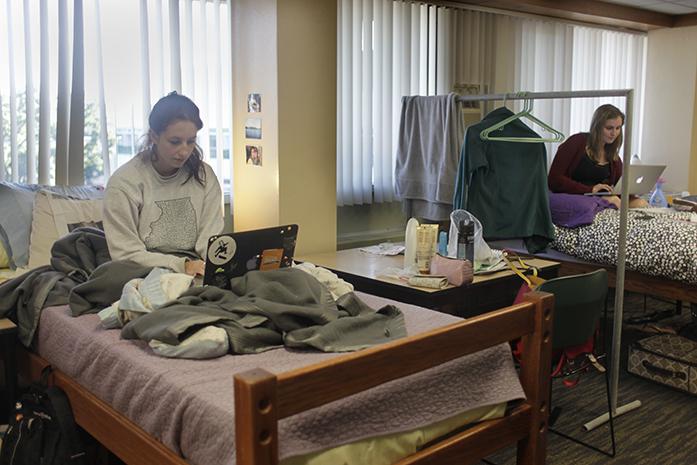For some, UI living arrangements are up in air.
By Cindy Garcia
[email protected]
As students settle into their new dorm rooms for the rest of the semester, the place University of Iowa freshman Selim Lee temporarily calls home is a study lounge in Rienow Hall.
Lee is one of more than 130 students who reside in temporary or expanded housing, usually caused by handing in housing applications late.
Expanded housing alleviates a recurring problem of crowding, but it may see an end with the construction of the Madison Street dormitory in 2017. In the meantime, UI Housing & Dining is seeking other solutions.
Lee said she was told about her living arrangements via email.
“I didn’t expect it,” she said. “I expected to get a permanent room, but I got the temporary room, so I was a little disappointed.”
Another UI freshman, Joshua Vargas wasn’t so surprised.
“On ISIS, it showed that we had temporary housing,” he said. “It also showed a list of all eight roommates. So we knew we were going to be here for a bit.”
Both students said they had little to complain about. Also, the two applied for housing late.
“I think it’s good. It’s better than I thought before I arrived here because the facilities are good,” Lee said, pointing out the quality of the furniture and air conditioners.
“It’s fine,” said Vargas, who was told he would have a permanent room in two to four weeks. “We have no problems with any of our roommates, but it is kind of crowded, so that’s kind of a bad aspect.”
Even though Vargas and Lee are part of the largest freshman class in UI history — estimated to hit 5,000 students — Von Stange, an assistant vice president for Student Life and the senior director of UI Housing & Dining, said the number of students in expanded housing has actually decreased.
Last fall, there were about 160 students in such housing.
This is largely because of the addition of Petersen Hall, which has a capacity of 501, Stange said. Besides Petersen, UI Housing & Dining also made other arrangements to accommodate students.
“We added almost 80 beds of leased off-campus properties for our returning students, and then we moved some students around, and we created more triples in the residence halls to come up to 650 beds,” Stange said.
However, these accommodations may prove to be a temporary fix when Quadrangle, a building with a capacity of 360, is demolished next year.
“We’re looking at a combination of leasing or finding more space for students by finding new buildings or new apartments,” Stange said. “We’ll also look at more triple rooms in the residence-hall system — not a lot, but a few more — and then restricting the number of returners who are coming back to the residence halls. It’ll most likely be a combination of all three.”
The issue is further exacerbated by the potential for larger freshman classes in the future.
“Next year, there’s been no clear direction on whether the university’s going to grow or going to stay stable — we haven’t gotten any of that information from anyone right now,” Stange said.
He said he expects most housing problems to end when the Madison Street dorm opens in the fall of 2017, adding 1,050 beds to the UI housing system.
That dorm may eliminate the need for expanded housing and leased off-campus apartments, whose leases run out in 2017. The planned dorm may even allow upperclassmen to return to the residence halls.
“I think we have more flexibility in what we’ll be able to do” Stange said. “2016 is going to be hard because we’re going to have to have fewer beds than we did and probably the same number of students. But in 2017, we’re going to have opportunity.”



